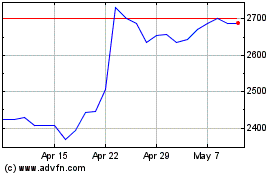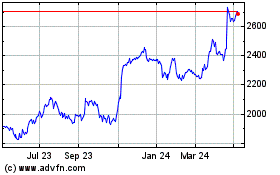Primark Owner Relies on Cost Cutting, Government Help to Manage Coronavirus Fallout, CFO Says
March 27 2020 - 4:57PM
Dow Jones News
By Nina Trentmann
Associated British Foods PLC is cutting costs and relying on
government assistance to protect its balance sheet while its
Primark fashion stores are closed during the coronavirus
pandemic.
Primark, which accounts for about half of ABF's earnings before
interest and taxes, doesn't have an online store and depends on
foot traffic to generate sales.
"If all of your stores are closed, your sales are zero," ABF
finance director John Bason said in an interview Thursday. "The
focus is very much on cash flow and on cash going out."
London-based ABF said Monday it closed all 376 Primark outlets
in 12 countries and forecast a net sales loss of about GBP650
million ($811 million) a month. It is unclear how long the store
closures will last, but Mr. Bason expects ABF to recover about 50%
of operating costs through subsidies, negotiations with landlords
and other measures.
Wages for about 78,000 employees make up the bulk of Primark's
operating costs of about GBP220 million a month, and government
assistance programs launched in response to the crisis will cover
about 75% of salary costs in Europe, Mr. Bason said.
Under these programs, governments in the U.K., France, Italy,
Spain, Germany and other European countries pay companies around
75% to 80% of salary costs for employees who are not working
because of the coronavirus, assuming that employees retain their
jobs, according to recent announcements by various governments.
"This can lead to significant cost savings during the period of
store closures," analysts at Berenberg Bank said in a note to
clients.
The financial relief from these job retention programs will come
with a certain delay; many governments haven't specified when they
would start making payments, said AllianceBernstein LP analyst
Aneesha Sherman. "At the moment, retailers still have to front wage
costs," she said, estimating that ABF's Primark operations in the
U.K. could expect to get funds from the government by the end of
April.
ABF said this week it has cash resources of about GBP800 million
and a revolving credit facility of GBP1.1 billion, bringing its
total available liquidity to about GBP1.9 billion. Mr. Bason
declined to comment on whether the company would seek additional
loans or other types of funding in the coming weeks.
"They can survive the quarter without additional funds," Ms.
Sherman said.
The company is negotiating with its landlords to reduce rent
obligations, Mr. Bason said. Those efforts could result in a
permanently lower cost base for Primark, said Ms. Sherman, adding
that competitors Next PLC and H&M owner Hennes & Mauritz AB
are pursuing similar efforts.
A decision by the U.K. government to exempt retail, leisure and
hospitality businesses from paying business rates -- a form of
property tax -- also helps the company, Berenberg analysts
said.
ABF stopped placing new orders with its suppliers, but pledged
to pay for goods already en route to Europe. "We said, 'Don't
produce anything more for us,' " Mr. Bason said. Primark has about
1,000 suppliers globally, including 600 in China, he said.
Clothing retailers such as Zara-owner Inditex SA and Boohoo
Group PLC have taken similar measures.
"It is the right decision, because otherwise you have large
amounts of inventory that would bind a lot of working capital," Ms.
Sherman said.
ABF benefits from having other businesses, including food and
sugar production. The grocery unit, which makes products such as
Twinings tea and Patak's sauces, has seen stronger demand in recent
weeks, Mr. Bason said.
"What we have seen is a big shift to home cooking," he said,
noting that it's too early to tell whether the grocery business
could help offset losses at Primark.
Write to Nina Trentmann at Nina.Trentmann@wsj.com
(END) Dow Jones Newswires
March 27, 2020 16:42 ET (20:42 GMT)
Copyright (c) 2020 Dow Jones & Company, Inc.
Associated British Foods (LSE:ABF)
Historical Stock Chart
From Mar 2024 to Apr 2024

Associated British Foods (LSE:ABF)
Historical Stock Chart
From Apr 2023 to Apr 2024
